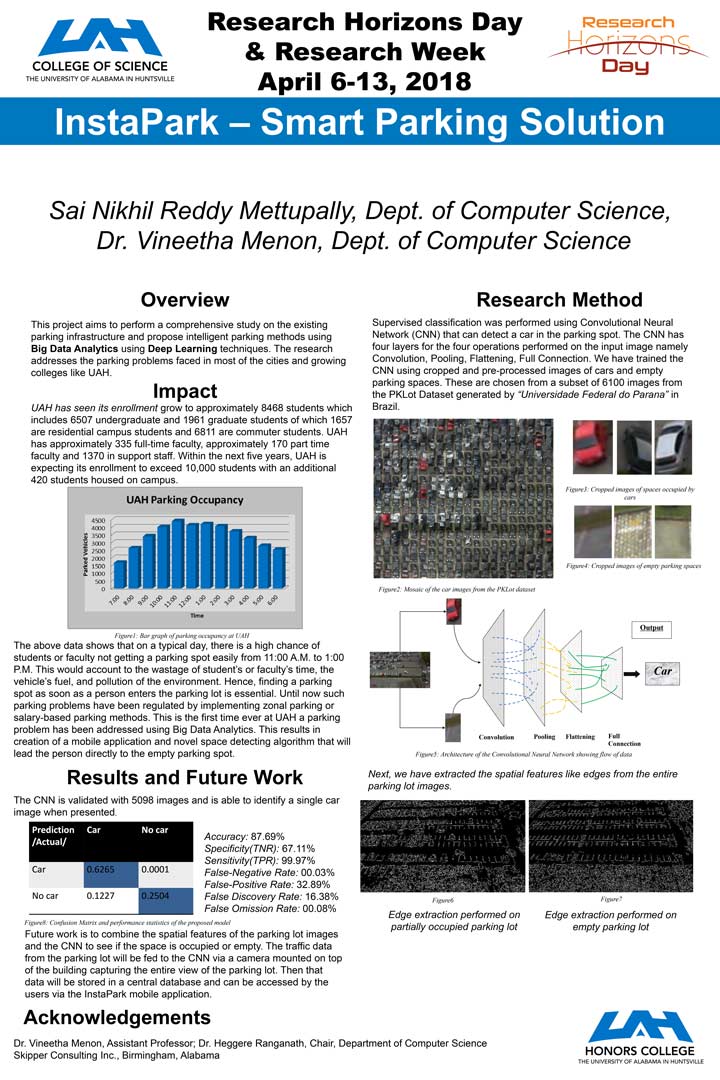
Sai Nikhil Reddy Mettupally, a computer science master’s student, won second place in the graduate master’s division at the 2018 Science and Technology Open House with his entry entitled "Comprehensive Parking Study at the University of Alabama in Huntsville Using Airborne Sensors."
As a busy graduate student at The University of Alabama in Huntsville (UAH), Sai Nikhil Reddy Mettupally doesn’t have a lot of time to waste driving around campus looking for a parking spot. And he’s not alone. A recent report from leading transportation specialist INRIX showed that Americans spend an average of 17 hours a year searching for a place to park at an estimated cost of $20.4 billion in wasted resources. Yet instead of getting annoyed like the rest of us, Mettupally decided to tackle the problem head-on – by developing a novel space-detecting algorithm that relies on Big Data analytics and deep-learning techniques to lead drivers directly to an empty parking spot.
Mettupally, a master’s candidate in UAH’s Department of Computer Science, conceived the idea shortly after the university transitioned to zone parking last fall. "The data show that, on a typical day, there is a high chance that students or faculty members will have difficulty getting a parking spot between 11 a.m. and 1 p.m., leading to the wastage of time and fuel, and adding to the pollution of the environment. Hence, finding a parking spot as soon as a person enters the parking lot is essential," says Mettupally, who earned his bachelor’s degree in Electronics and Communications Engineering from the Birla Institute of Technology and Science in Pilani, India.
Finding a parking spot as soon as a person enters the parking lot is essential.
What he needed, he realized, was to find a way to identify empty spaces and then direct the driver to their location. But unlike other parking apps on the market, he wanted to develop one that didn’t rely on the purchase, installation, and maintenance of expensive in-ground sensors. Instead, his would employ a convolutional neural network (CNN) capable of analyzing and classifying imagery collected via a video surveillance camera to detect whether or not a given parking spot is empty. To help put his plan in action, Mettupally turned to Dr. Vineetha Menon, an Assistant Professor of Computer Science. "Dr. Menon had vast experience in dealing with huge amounts of data, so I pitched my idea to her and she supported me," he says.
As the director of UAH’s Big Data Analytics Lab, Dr. Menon also had access to the high-performance computing power that Mettupally needed to create and train his machine-learning model, which relies on a robust parking-lot dataset provided by the Federal University of Paraná in Brazil. "The goal of the Big Data Analytics Lab is to establish Big Data Analytics and Data Science as mainstream research areas of the university, so it can accommodate the high computational and memory demands of Big Data generation and processing," she says. "In the lab, students can learn how to apply Big Data methodologies in multidisciplinary domains such as remote sensing, biomedical data processing, computational biology, molecular biology, and cybersecurity. And they can use it to develop Big Data Analytics algorithms, like Nikhil’s, for addressing cross-disciplinary challenges."

Mettupally took first place in the College of Science’s graduate poster category at this year’s Research Horizons Day poster session with his entry entitled “InstaPark – Smart Parking Solution.”
By April, Mettupally had gotten far enough along that he was able to present his research at UAH’s fourth-annual Research Horizons Day poster session, ultimately taking home first place in the College of Science’s graduate poster category. And by September, he was able to hold his own among his peers across the state, winning a second place award from Alabama EPSCoR in the graduate master’s division at the 2018 Science and Technology Open House: Showcasing STEM Activities across Alabama Institutions. "I felt I had won when I presented my research and the judges liked it," he says. "It was really magical."
Less magical have been the kinks Mettupally has encountered since then, such as getting the machine-learning model to differentiate between an empty space and a black car. "My model has four layers, but I plan to increase it to a greater number of layers and train it with pre-processed images. More focus needs to be put on the pre-processing of the images to improve the results" he says. Then there’s the whole problem of object localization. "Object detection, which tells you if there is a car present or not, is not a problem, but object localization, which tells you where the car is, is difficult," he says. "I have done object detection before, but I haven’t done object localization, so I am teaching myself."
After that, he hopes to develop a parking-support mobile app – dubbed InstaPark – that can display the real-time grid layout of empty and occupied parking spots using the phone’s GPS. "The app could then be constantly updated based on parking information from the cloud classifier," he says. "This would assist both UAH students and employees in managing their time efficiently in finding their closest parking spot, help ease the traffic flow on campus, and provide better parking management services."
Of course, with graduation in December, Mettupally is in increasing danger of missing his self-imposed deadline of getting everything done before he leaves UAH. "It’s hard to squeeze in time for it these days, because I have mid-terms and assignments and I’m interviewing for jobs" he says with a laugh. And yet he is determined to see it through, and not just because commercializing his unique technology may one day make him a rich man. Rather, it’s because he knows from personal experience how incredibly frustrating it is to drive around looking for parking. "I’ll be happy," he says, "if I can solve a problem that bothers a lot of people and help save their time and resources."